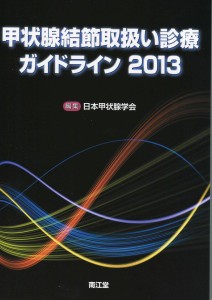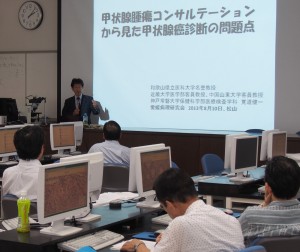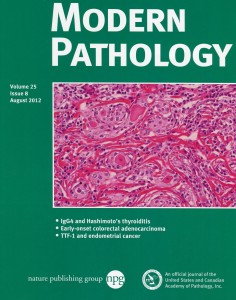病理医の方へ
愛媛病理研究会
2013/08/20
8月10日、愛媛大学北澤教授のお招きで、愛媛病理研究会で講演の機会を得ました。バーチャルスライドによる症例検討会で、楽しい時間を過ごすことができました。
category: 病理医の方へ , 細胞診専門医、細胞検査士の方へ comment: (1)
甲状腺結節取扱い診療ガイドライン
2013/07/30
甲状腺学会編集、甲状腺結節取扱い診療ガイドラインが南江堂から出版されました。甲状腺穿刺細胞診と病理診断の問題点について我々病理医4名で取り組みました。ここでの新規軸は、甲状腺穿刺細胞診の診断様式に、伊藤病院、隈病院など日本の甲状腺専門医療機関で開発された診断様式を取り上げたことです。一般病理医、細胞検査士に同レベルでの診断がどこまで可能かと疑問が投げかけられましたが、わたくしは可能と強くはねつけました。是非病理専門医、細胞診専門医、細胞検査士の方々は、ご一読いただいて、甲状腺専門医療機関の独自に開発した診断様式の趣旨をくみ取っていただきたいと思います。細かいことは省略いたしますが、現在欧米で普及しています、べセスダ診断様式、英国様式と診断用語や、臨床的対応に違いがありますが、細胞所見には全く違いがありません。どの診断用語を用いるか、臨床側パートナーとご相談の上お決めください。このHPにご意見を頂ければ幸いです。具体的には、嚢胞液が得られた検体で、濾胞上皮細胞が6集塊得られないとき、べセスダでは全例再検査、検体不適の診断となります。甲状腺学会のガイドラインでは、嚢胞液が確認されれば、良性と診断し、画像で悪性も考えられる例のみを再検査とします。画像診断が進んでいる日本の実際的な方針です。


category: 病理医の方へ , 細胞診専門医、細胞検査士の方へ , 臨床医の方へ comment: (0)
2013年前期の論文活動
2013/07/18
2013年前半の論文活動を報告いたします。
論文としては
- Morioka T, Ohba K, Morita H, Takahashi G, Uchida H, Matsushita A, Sasaki S, Oki Y, Suda T, Kakudo K, Yoshino A: Non-islet cell tumor-induced hypoglycemia associated with macronodular pulmonary metastases from poorly differentiated thyroid carcinoma. Thyroid, 2013 May 23 Epub ahead of print.
- Kakudo K, Mori I, Liu Z, Hui Z, Kakudo M, Wakasa T: Papillary microcarcinoma and microtumor of the thyroid gland. J Basic & Clin Med, 2:1-6, 2013.
- Wakasa T, Shintaku M, Tanaka S, Yamada K, Li Y, Kakudo K: Morphological Changes of follicular cells in Hashimoto’s disease: A possible cause of overdiagnosis in cytology. J Basic & Clin Med, 2:12-16, 2013.
- Kakudo K, Bai Y, Ozaki T, Homma K, Ito Y and Miyauchi A: Intrathyroid epithelial thymoma (ITET) and carcinoma showing thymus-like differentiation (CASTLE). CD5-positive neoplasms mimicking squamous cell carcinoma of the thyroid. Histol Histopathol, 28: 543-556, 2013.
アメリカの甲状腺癌患者からの手紙
2012/09/18
医学研究に携わって多くの論文を書いてきましたが、研究内容が地味(?)なため、また基礎研究で重箱の隅をつつく内容(?)であるため、今まであまり注目を集めることはありませんでした。また治療に直接関与していないため、患者さんから感謝の言葉をいただいたこともありませんでした。しかし、先週初めて以下のようなmailを、面識のない患者(病院名、患者名は個人情報のため伏せさせていただきます)からいただき、インターネット情報はすごい、研究論文を書くことで患者に情報を発信し、時に役に立っているのだと実感することができ喜んでいます。どのような内容の論文であるか興味のある方はhttp://onlinelibrary.wiley.com/doi/10.1111/j.1440-1827.2011.02773.x/full をご参照ください。
Dear Dr. Kakudo,
I wanted to write and thank you for publishing your comprehensive review of the literature on encapsulated thyroid tumors, and your related papers. I am referring to Classification of thyroid follicular cell tumors: with special reference to borderline lesions (2011), and Encapsulated papillary thyroid carcinoma, follicular variant: a misnomer, (2012), which make many salient points and provide an excellent review of the literature for both professionals and interested patients.
I am a patient who was diagnosed with an encapsulated, mutation-negative, non-invasive thyroid cancer in 2011 in the United States. The pathology report read that it was an encapsulated classic PTC. I did wonder a bit at the time whether there could be some kind of question or error about the diagnosis because the tumor did not appear to have been behaving in a way that
could be construed as aggressive. There was no spread to the nodes or outside the thyroid, molecular tests revealed no known genetic mutations and I was also tg undetectable, both basal and stimulated. I was puzzled, and I did see while looking online that there was some kind of controversy about encapsulated FVPTC, but I was told that I didn’t have FVPTC and also that there are many cases of mutation negative thyroid cancer. I was also told that I was “low risk” but on the advice of my endocrinologist I submitted to a treatment of radioiodine (50 mCi). Like many or even most patients, when I was diagnosed I really had very little idea of the definition of thyroid cancer according to tumor classification and how that plays into the reasoning of a given pathologist. I had no way of contextualizing “thyroid cancer” in a more meaningful way. It seems that the hospital that I used treats classic encapsulated PTC the same as garden variety non-encapsulated PTC. I had no idea that encapsulated PTC could be
regarded as being under the same umbrella as encapsulated FVPTC until I did a Google search about it and saw your papers, which elucidate very effectively the problems of inter-observer variation among pathologists and also the questionable ascendency of PTC-N as a major diagnostic criterion. I would even go beyond that and say that any patient with this type of thyroid tumor who has been diagnosed with cancer and who can read and understand your reports will probably come away feeling rather
disturbed, or at the very least disconcerted by the implications. A cancer diagnosis entails a considerable psychological burden even when the prognosis is good.
It really surprised me to learn of the observer-dependent nature of the line between benign and malignant in certain situations. But I guess what unnerved me the most is the realization that pathologists and other clinicians at times actually do not know with certainty the true nature of some lesions due to the limitations of current knowledge. Yet these cases will nevertheless often be translated to the patient as definitively being cancer. How is a patient to react when confronted with this actuality, other than by experiencing a lessening of confidence in the way in which thyroid pathology is being conducted in many hospitals and also with nagging uncertainty about whether their case has been over-treated? I feel that I was not empowered as a patient and that more transparency is needed in medical practices as to the gaps in understanding in the current classification system, and the resultant gray zones in diagnosis which directly impact the lives of patients like me.
It seems to be the case that there is a certain segment of patients who are the unwitting “poster children” of this gray zone in thyroid pathology. My case proceeded on the basis of PTC-N (FNA and pathology) alone because the molecular results were negative. These uncertainties which have been unmasked by your reports suggest to me that a borderline category based upon degree of invasiveness is a very sensible solution until more hard data becomes available. At least I can attest to what a difference it would have made to me personally. Had I known of your research before I had my surgery and treatment, I may have
insisted on a lobectomy and almost certainly would not have agreed to receive RAI ablation. Since I saw your papers I conferred with a second pathologist from New England about them, and he confirmed that the diagnosis of these “very low grade lesions” is
subjective and sometimes even amounts to a “suggestion” from the pathologist. I only wish that my original pathologist could have somehow conveyed this information to me. Maybe many pathologists and clinicians in the USA and elsewhere feel that their
hands are tied due to legal concerns, but I think that for patients a borderline category makes very good sense and most likely will prevent overtreatment and psychological trauma. It would have made such a difference for me in that it would have allowed for a lesser degree of treatment while preserving appropriate follow-up.
Thank you again, Dr. Kakudo.
IgG4甲状腺炎の論文がModern Pathologyに掲載されました。
2012/08/28









